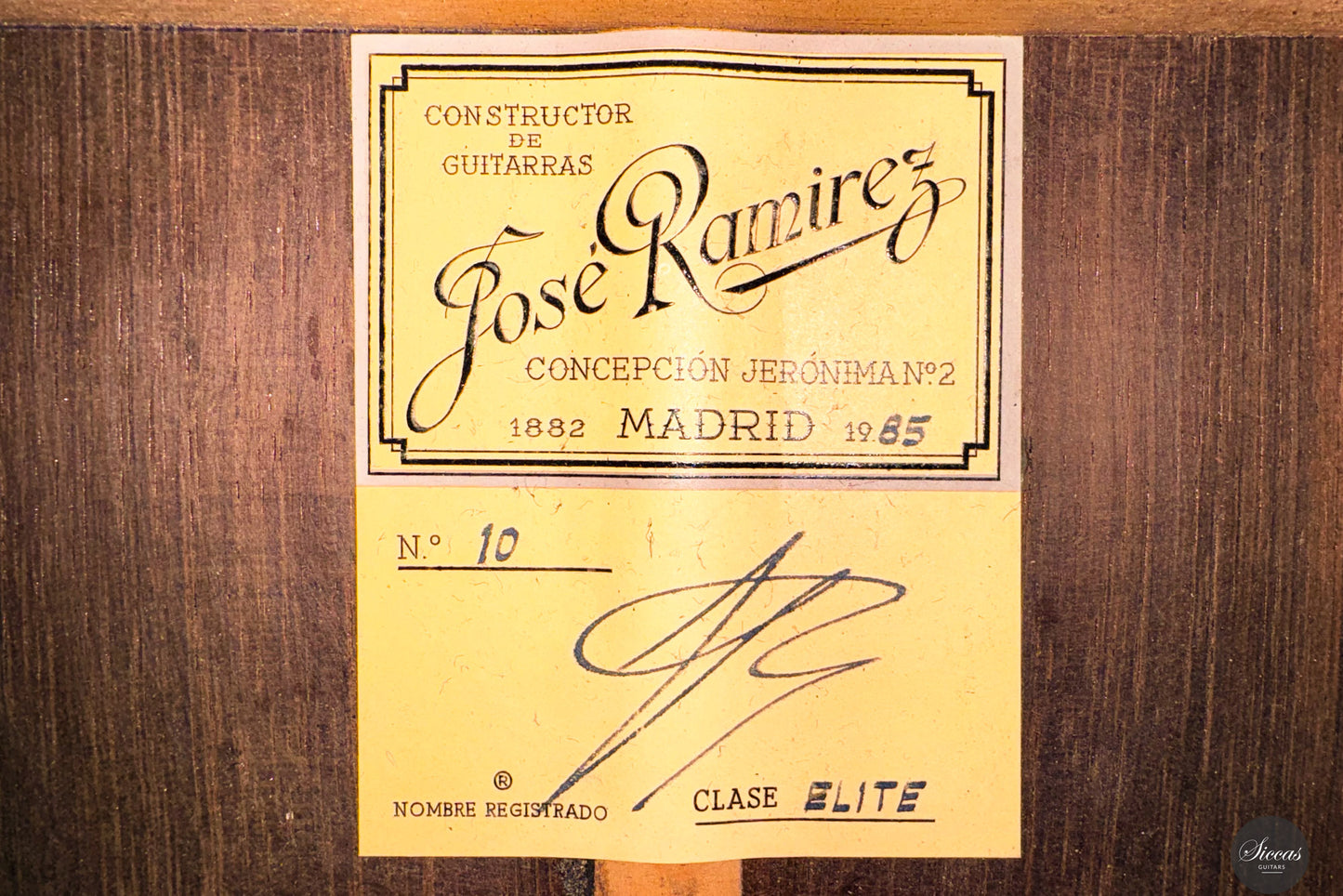Jose Ramirez III - 1985 - Elite - 66,4cm
Jose Ramirez III - 1985 - Elite - 66,4cm
Details
Details
Overview
Overview
Shipping important note
Shipping important note
Delivery times are typically reliable and most instruments arrive within the estimated timeframe.
Should any unexpected delay occur, our team will keep you informed and provide support at every step. For all shipping details and exceptions, please see our Shipping Policy.
Details about GPSR
Details about GPSR























More details about the guitar
About the luthier
The Ramirez family has been building fine and high-quality guitars since 1882 already. Their instruments have been and are played by some of the greatest guitarists in the world, such as Julian Bream, Andres Segovia, Laurindo Almeida, Oscar Ghiglia, José Luis Gonzales, and many others. Ramirez is an integral part of the history of guitar building. José Ramirez I (1858-1923) trained many guitar builders in his workshop at the end of the nineteenth and beginning of the twentieth century. And José Ramirez III (1922-1995) pioneered using cedarwood as top wood for guitars and built several guitars for Andres Segovia. José Ramirez III (1922-1995) pioneered cedar tops for guitars. His instruments gained international fame in the 1960s through Andrés Segovia and his many students. In 1965, José Ramirez III began developing a new instrument built with a top made of Western Red Cedar (Thuja plicata) and double sides (rosewood and cypress). This revolutionary new way of building guitars and using this innovative type of wood spread very quickly in the guitar world. In addition, Andrés Segovia played several J. Ramirez III was his main concert instrument. He played four instruments over an extended period [1962 (but dated 1963), Spruce, 1965, 1967, 1969 (all three cedar).About the guitar
This exceptional 1985 José Ramirez guitar, model Elite, is widely regarded as one of the “holy grails” among Ramirez instruments. As the name suggests, it represents one of the highest-tier models ever produced by the legendary Madrid workshop. The CITES-certified Brazilian rosewood back and sides are truly to die for—this kind of wood is extremely rare nowadays, if not impossible to find. The guitar is also fitted with Rodgers tuning machines, which are widely considered the best in the business in terms of both functionality and craftsmanship. The guitar embodies the distinctive tonal characteristics for which Ramirez is celebrated: romantic, silky-smooth trebles that invite expressive portamento, and deep, mysterious basses that provide a rich foundation. Its impressive volume makes it a powerful concert instrument, suitable for any performance setting.Condition
Although a pre-loved instrument, it is in near-mint condition, with no structural issues and only the faintest signs of playing wear.Regular care extends the life of the instrument
Even with careful use, a classical guitar may gradually change in appearance or respond to unstable storage conditions. Have a close look at your guitar regularly and be attentif to changes. If your instrument is suffering from its environement, it will let you know.
Protect Your Guitar: Handle with Care
Be mindful when touching your instrument with greasy or unwashed hands: any skin contact is a small attack on the varnish. Of course, a guitar is made to be played, but taking a few precautions helps preserve its beauty: wash your hands before playing, wear long sleeves, and avoid unnecessary direct skin contact with the body of the instrument.
Pro tip: Avoid playing with a button-up shirt, heavy jewelry, or a belt, as these can scratch the guitar. Also, make sure your guitar case is free of any objects that could damage the instrument during storage.
String care
A good habit to adopt is wiping down your strings briefly after each playing session. This small action significantly extends their lifespan and helps maintain a consistent, comfortable feel under your fingers.
Most importantly, clean strings are essential for keeping your instrument in tune. Corrosion, sweat, and dust can affect the uniformity of the strings and interfere with accurate tuning across the entire fingerboard.
Pro tip: If you're having trouble getting your guitar in tune, it might be time to change the strings. A useful test is to compare the pitch of the 12th fret harmonic with the fretted note at the 12th fret; if there's an unusually large gap between them, your strings may have lost their integrity and should be replaced.
Keep Your Shellac Finish Shining!
Got a guitar with a shellac (French polish) finish? Here's a simple trick: Take a clean microfiber cloth and gently breathe on the surface to create a light mist. Then, softly rub to remove fingerprints, sweat, and grease. That’s usually all it takes to keep it looking great, no products needed!
Pro tip: Every few years, treat your guitar to a check-up with a luthier to keep it in top shape.
Storing Your Guitar: Climate Matters
Your guitar can safely stay outside its case, as long as the surrounding environment maintains 42–55% humidity and a temperature between 18–25°C.
Keep in mind that humidity levels can still fluctuate inside the case, especially during seasonal changes.
- Too much humidity may cause overtightened strings and a dull tone.
- Too little humidity can lead to a bulging top, string buzz, or even cracks.
Avoid placing your guitar near radiators, air conditioners, or windows with direct sunlight.
Pro tip: Always close your guitar case while playing. This helps preserve a stable microclimate inside the case, so your instrument is protected the moment you put it back in.















































